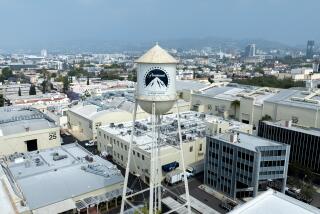Camera Cache Competition : Movies: A Burbank company is trying hard to catch up with Panavision. But they’re still pretty far behind the film industry’s most popular supplier.
- Share via
During the filming of “Backdraft,” the 1991 movie about Chicago firefighters, cinematographer Mikael Salomon donned fire-retardant clothing and carried a camera through burning buildings. Then he poured flammable glue over the camera--which was encased in protective housing--and left it running as the inferno closed in around it.
Later, the film crew dug through the ashes and rubble and removed the camera. It was undamaged.
Clairmont Camera, a Burbank company, rented the camera to Salomon and built the protective housing specially for him. It earned his gratitude, he says: When it comes to challenging jobs, the people at Clairmont “always want to make it work.”
But when he filmed Steven Speilberg’s “Always,” Salomon turned to the biggest supplier of motion picture cameras to Hollywood, Tarzana-based Panavision. Speilberg preferred Panavision, and “he didn’t want to change,” Salomon said.
So it goes for Clairmont, working hard to grow in the shadow of the industry giant.
In the 16 years since they founded the company, brothers Terry and Denny Clairmont have built a reputation for excellent service and custom-designed solutions. Clairmont is now No. 2--but a distant No. 2--behind Panavision and is followed closely by No. 3 Otto Nemenz International. Together the three companies account for about 85% of the local movie camera rental market.
Clairmont has grown steadily, expanded into new markets and continued to add new cameras, lenses and other equipment to an inventory now worth between $35 million and $50 million.
“We’ve got hundreds of things that most people don’t know about because we made it for one guy,” said Terry Clairmont. “Then people walk in with a special problem, and we’ve already got the thing built. Those custom items a lot of times are what bring a customer to us.”
At least for the near future, Clairmont seems destined to remain in Panavision’s shadow. Clairmont and its competitors won’t disclose their revenues, but an idea of their relative size can be gleaned from their inventories. Panavision has about 430 cameras in the local marketplace, as opposed to Clairmont’s 170 and Otto Nemenz’s 130.
The main difference between Panavision and Clairmont, filmmakers say, is that Panavision makes its own cameras and accessories. The others rent out cameras that they buy from manufacturers, chiefly Arriflex of Germany, the world’s biggest motion picture camera maker.
That’s an important distinction to cinematographers, whose decisions on whether to go to Panavision or Clairmont are largely based on what kind of cameras they want. For some cameramen, Panavision is the hands-down choice, like asking “Why drive a Mercedes over a Volkswagen?” said Conrad W. Hall, an aspiring cinematographer whose father, Conrad L. Hall, filmed movies including “Butch Cassidy and the Sundance Kid” and “Tequila Sunrise.”
Cinematographer Jan DeBont (“Basic Instinct,” “The Hunt for Red October,” “Lethal Weapon 3”) said he’s impressed with Clairmont’s aggressive pursuit of business by catering to filmmakers’ special needs.
For instance, Clairmont redesigned a Canon still-photography zoom lens for use on a motion picture camera--a feat that won Clairmont an Academy Award for technical achievement this year.
Nonetheless, DeBont typically sticks with Panavision.
Many filmmakers believe that Panavision’s local manufacturing makes it more responsive. “We’re right here,” said Phil Radin, Panavision’s executive vice president of marketing. “We can react very quickly to the needs and requirements and trends in the industry.”
Clairmont is “kind of at the mercy of a company that’s in Germany,” Radin said.
Also, while Panavision has historically been more expensive than others, the rent gap has virtually closed in recent years. Producers spend anywhere from $3,000 to $12,000 a week renting Clairmont’s equipment, depending on the number of cameras and special equipment used.
More important, cinematographers say, is that Panavision makes a complete, interchangeable camera system. Panavision’s highly regarded Primo lenses, for instance, fit all its cameras. Clairmont pieces together its camera systems from various manufacturers such as Arriflex and lens maker Zeiss.
The Clairmonts contend such comparisons with Panavision are outdated. Clairmont, they argue, is now Panavision’s equal when it comes to technology and responsiveness to its customers. Grabbing more market share now means “striking personal relationships between us and the producers,” Denny Clairmont said. “It’s going to be a personality contest.”
Recently, however, Clairmont’s growth plans have run headlong into the recession, which has hurt all equipment rental companies as production and advertising budgets have been cut. Clairmont, which catered almost exclusively to commercial producers in its early years, still derives about 50% of its revenues from that business.
The company’s total revenues had grown about 20% a year through 1990, Terry Clairmont said, and based on that growth rate, Clairmont bought $6 million in new equipment last year. But 1991’s revenues were flat, and this year the typical April production slowdown has resulted in a 50% drop in business from the busy June-through-March period, rather than the usual 25% decline.
As the economy recovers, Clairmont might get some help from Arriflex’s newest camera, the 535, which has more of the bells and whistles cameramen look for in a complete system. Clairmont has five of the cameras and one more on order.
Despite Panavision’s dominance, said Stephen C. Chamberlain, an Arriflex Corp. spokesman, Clairmont has “some very loyal customers.” Many European filmmakers prefer the German-made Arriflex. Cameramen find little fault with Clairmont’s workmanship--a critical concern in a field where equipment breakdowns are costly and the tolerance for camera error is low.
Industry insiders also see Terry and Denny Clairmont’s intimate knowledge of the film business as a plus. Terry, 49, is the company’s chief executive and oversees the photographic side of the business. Denny, 56, is president and manages technical operations. Denny’s son John is vice president and rental manager.
The Clairmont brothers’ father was a Hollywood cameraman, and they got an early start in the movie business by working as extras when they were just 6 months old. They later went to work at Burns & Sawyer, another camera rental outfit. Denny stayed and became the firm’s technical manager. Terry left and worked as a cameraman for several years but says he was never satisfied with the rental equipment available. He and Denny borrowed money and began buying their own cameras. In 1976, with four cameras, they started their own rental company.
Clairmont now has about 15 types of cameras, 200 types of lenses, hundreds of filters and various other equipment such as tripods, magazines and camera heads. Recently released films that have been shot with Clairmont cameras include “The Babe,” “The Player” and “Wayne’s World.”
Clairmont has kept growing in recent years by moving into the budding British Columbia film market. It has an office with six employees at Stephen Cannell’s new studio facilities in Vancouver, where filmmakers go to escape the high costs of Hollywood.
The company plans to move in February to a new building in North Hollywood that is now under construction. The $7.5-million, 32,000-square-feet headquarters will allow Clairmont to add to its current staff of 75, Terry Clairmont said.
There’s another possible concern for Clairmont, the belief by some cinematographers that the film industry will eventually go entirely to video as technologies such as high-definition television emerge.
Does that make Clairmont’s race against Panavision irrelevant? Not according to Denny Clairmont, who says that producers will still put images on film first, then transfer them to video. “We’ll still have a business,” he said.
More to Read
The biggest entertainment stories
Get our big stories about Hollywood, film, television, music, arts, culture and more right in your inbox as soon as they publish.
You may occasionally receive promotional content from the Los Angeles Times.











